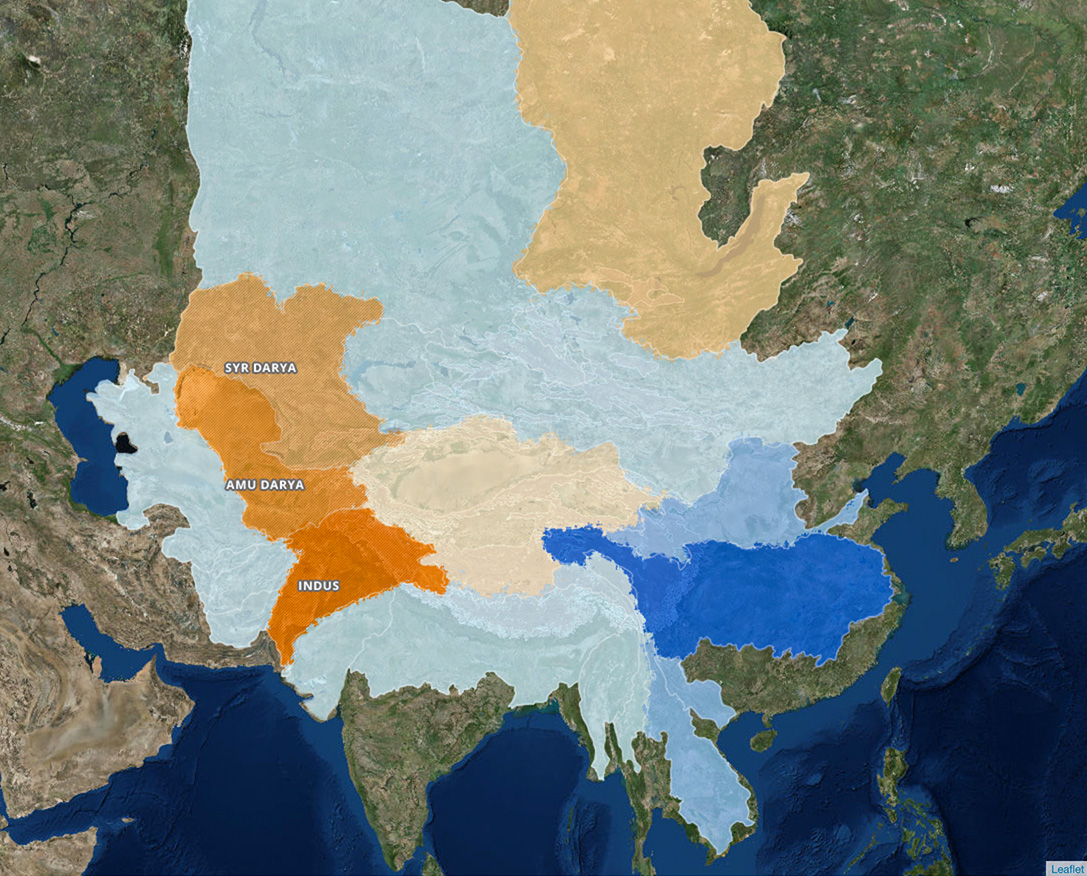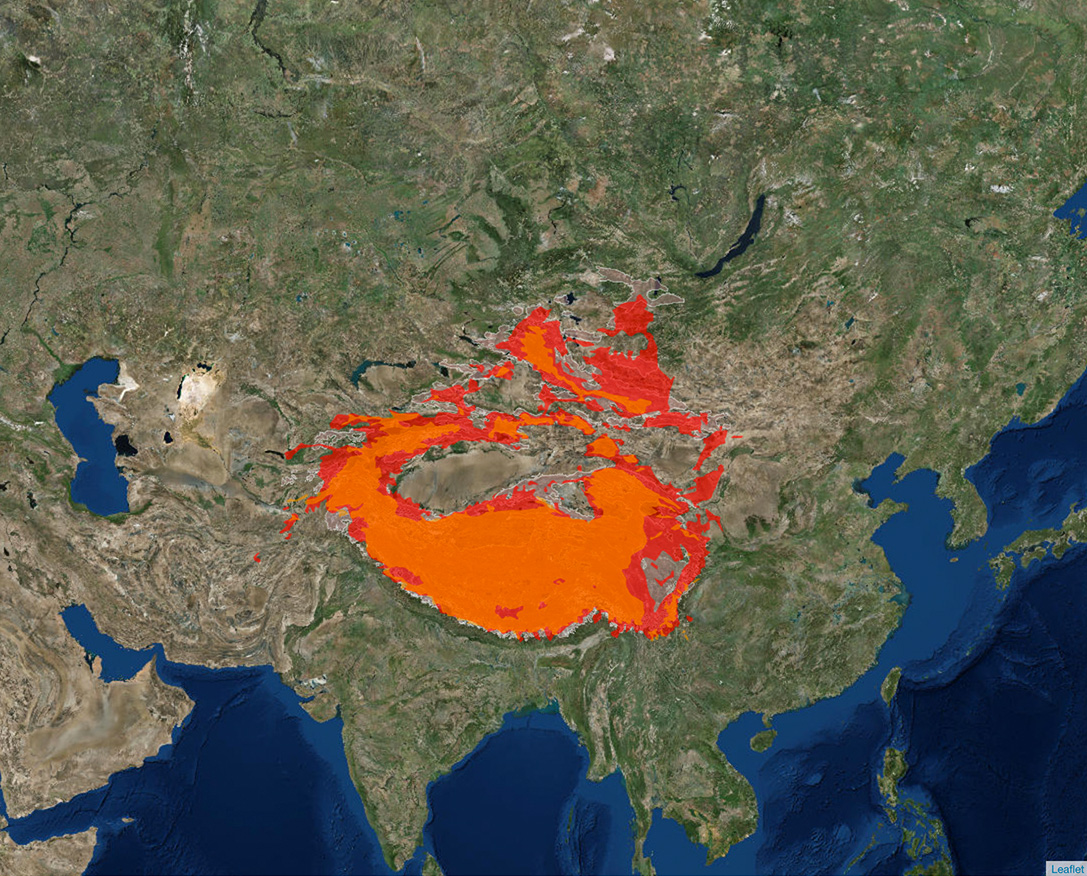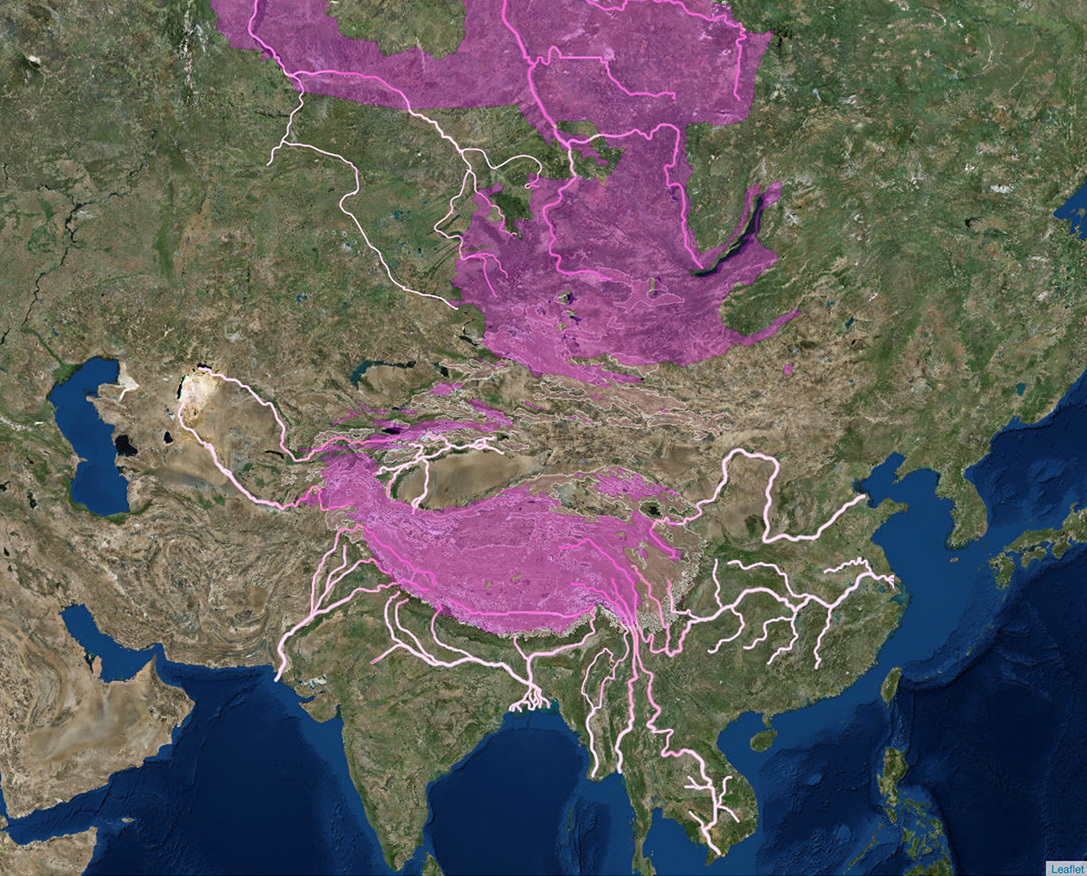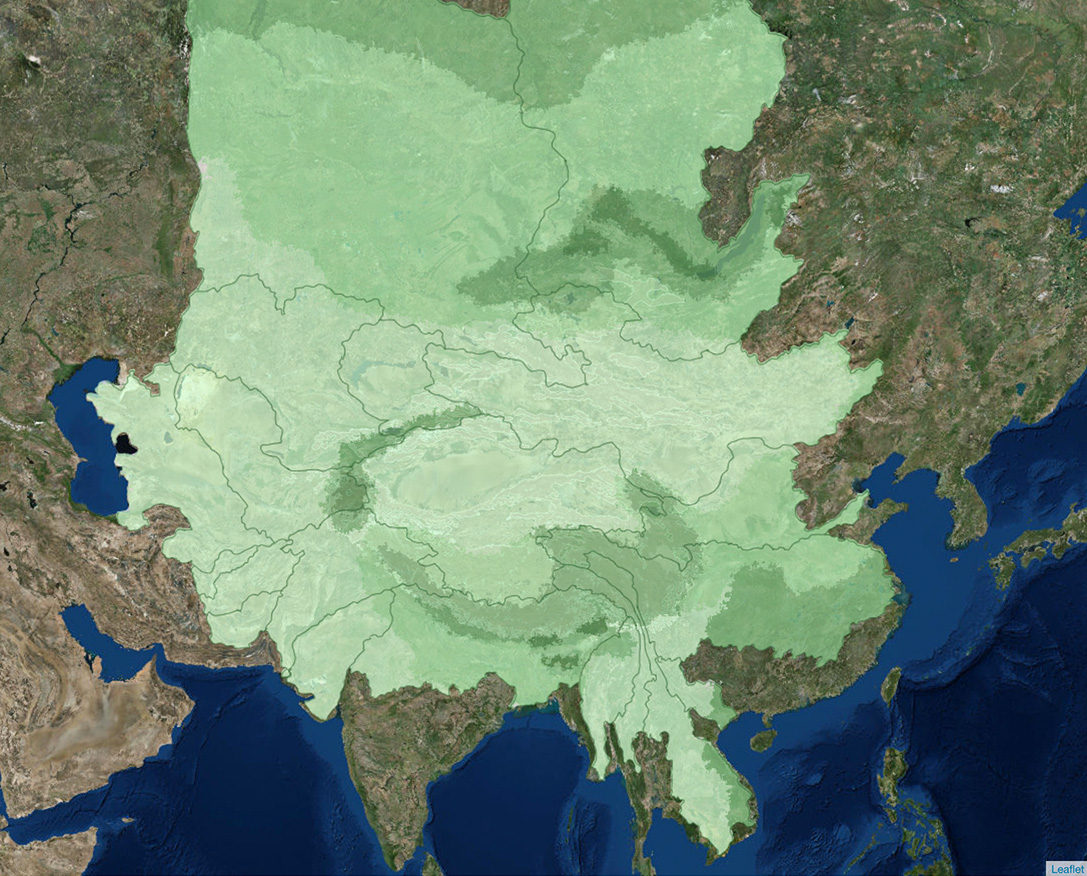Shared mountains, shared future
Millions of people depend on water that springs from the high-mountain headwaters of Central Asia. Its towering peaks are home to the endangered snow leopard, ancient cultures, and landscapes that are being too quickly transformed by climate change. We are working to maintain high mountain headwater areas through conserving critical ecosystems that include snow leopard habitat, and assisting local communities as they adapt to climate-driven changes to their water supplies. This interconnected climate-water-wildlife approach is novel, and it is the first time comprehensive, coordinated, climate-smart conservation is being implemented across the vast range of snow leopard habitat.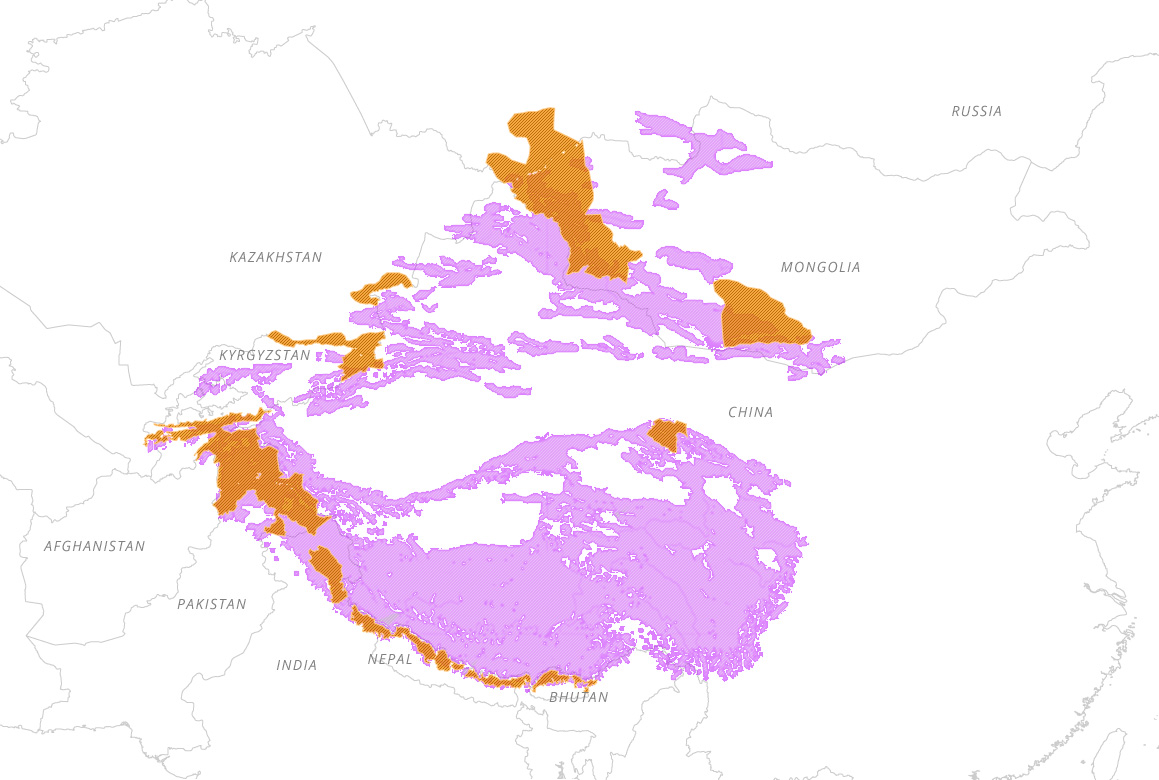
- GSLEP Landscapes Areas
- Potential Snow Leopard Habitat
The Snow Leopard Range
Although each range within Asia's high mountains has its own climate patterns and vulnerabilities, examining the snow leopard habitat at large reveals some common trends and provides a general overview of the region's threats and opportunities.Water Cycle
Precipitation in mm
- 0
- 50
- 100
The water cycle governing flows from high to low Asia is complex. The water cycle in the southern part of High Asia is largely driven by the monsoon that hits the eastern Himalayas, and moves westward, gradually becoming less severe.
Water Provision
Added Value - Water services in millions of people
- 0
- 50
- 100
This map indicates the relative importance of water originating from the snow leopard range to downstream human populations, on an annual basis.
People in positive "Added Value" basins (shown in shades of orange) rely disproportionately on water originating from the snow leopard range. Those people found in negatively ranked "Value Added" basins are more reliant on water originating from other parts of the basin (shown in shades of blue) strategy.
People in positive "Added Value" basins (shown in shades of orange) rely disproportionately on water originating from the snow leopard range. Those people found in negatively ranked "Value Added" basins are more reliant on water originating from other parts of the basin (shown in shades of blue) strategy.
Climate envelope
- No Projected Change
- Potential Habitat Loss
This map shows vulnerability in the suitable climate envelope for snow leopards to the year 2100. The analysis suggests that 39% of the current snow leopard climate envelope is vulnerable to loss under a high emissions climate scenario.
Upstream influence of Permafrost
Upstream percentage
- 0
- 50
- 100
This map depicts rivers according to the total amount of upstream permafrost. Any river that is on, or has a significant amount of its upstream on permafrost, is likely to undergo hydrological change based on retreating and shrinking permafrost. While there is considerable uncertainty around what will change, rivers on permafrost should be managed to anticipate potentially changed flows during and following melting.
Increased Aridity under 2ºC Temperature Rise
Percent change
- 0
- 50
- 100
This graph indicates that some of the eastern basins (Mekong, Halween, Huang He, Yangtze) may lose a considerable amount of humid area under a 2º temperature rise. On the other hand, the western basins (Indus, Amu Darya, Syr Darya) would not shift considerably toward greater aridity, making them perhaps more stable under climate change than the eastern basins.
Tracking the Snow Leopard
Some features of the ranging pattern of snow leopards in the Kangchhenjunga Conservation Area of Nepal(Based on satellite telemetry data from 2 snow leopards, Lapchemba and Ghanjenjemba)
Annual home range size (90 Percent Minimum Convex Polygon):
Male: 960 sqkm
Sub adult female: 2570 sqkm
Nearly 25 percent of overlap of home range between the two snow leopards
Elevation used:
Highest point: 5859 m -> Probably the highest elevation recorded for any wild cats of the world.
Daily distance travelled:
Annual average: 5.1 km/day -> shorter in summer (4.1 km/day) and longer in autumn (5.5 km/day)
Transboundary movement:
Frequent travels to India and China via mountain passes (movement corridors)
Kill rate:
One kill every 10 to 15 days.
Male: 960 sqkm
Sub adult female: 2570 sqkm
Nearly 25 percent of overlap of home range between the two snow leopards
Elevation used:
Highest point: 5859 m -> Probably the highest elevation recorded for any wild cats of the world.
Daily distance travelled:
Annual average: 5.1 km/day -> shorter in summer (4.1 km/day) and longer in autumn (5.5 km/day)
Transboundary movement:
Frequent travels to India and China via mountain passes (movement corridors)
Kill rate:
One kill every 10 to 15 days.
- Kangchenjunga Conservation Area
- Lapchemba
- Ghanjenjwenga
Annual home range size (90 Percent Minimum Convex Polygon):
Male: 960 sqkm
Sub adult female: 2570 sqkm
Nearly 25 percent of overlap of home range between the two snow leopards
Elevation used:
Highest point: 5859 m -> Probably the highest elevation recorded for any wild cats of the world.
Daily distance travelled:
Annual average: 5.1 km/day -> shorter in summer (4.1 km/day) and longer in autumn (5.5 km/day)
Transboundary movement:
Frequent travels to India and China via mountain passes (movement corridors)
Kill rate:
One kill every 10 to 15 days.
Male: 960 sqkm
Sub adult female: 2570 sqkm
Nearly 25 percent of overlap of home range between the two snow leopards
Elevation used:
Highest point: 5859 m -> Probably the highest elevation recorded for any wild cats of the world.
Daily distance travelled:
Annual average: 5.1 km/day -> shorter in summer (4.1 km/day) and longer in autumn (5.5 km/day)
Transboundary movement:
Frequent travels to India and China via mountain passes (movement corridors)
Kill rate:
One kill every 10 to 15 days.
How to live together
Community ownership is central to conservation and adaptation work in the forbidding mountains of high Asia.This project strives to raise awareness of the issues threatening Asia’s high mountain communities and encourages local participation in solutions that benefits both people and nature.
Through site-specific interventions, we promote climate-smart actions that integrate sustainable development, water security, and snow leopard conservation. Activities emphasize building capacity of local governments, increasing public understanding, and providing incentives to ensure that communities are empowered to protect snow leopards and the ecosystems that help safeguard the headwaters of rivers upon which millions of people depend.
